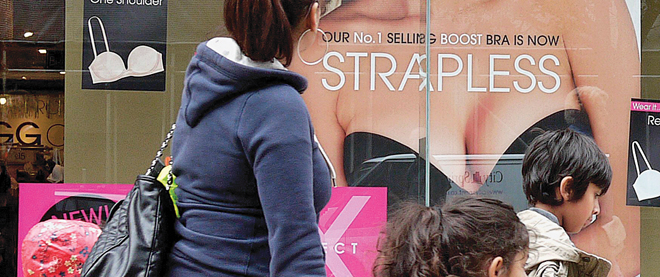No sex please, they’re children
The British government is trying to tackle the issue of kids’ sexualization
Chris Helgren/Reuters
Share

Culturally speaking, Britain is not a country known for its flagrant attitude toward sex, but today’s youth are bucking the trend. Teen pregnancy and sexually transmitted infection rates are shockingly high. But Prime Minister David Cameron seems bent on trying to deal with the problem in a roundabout sort of way. His government recently welcomed a plan to crack down on the sexualization of childhood by placing restrictions on advertisers, media outlets and manufacturers when it comes to sexual imagery or products directed at (or at risk of coming into contact with) children.
The government-commissioned Bailey report, led by Reg Bailey, the head of the Mothers’ Union, a Christian group for family welfare, was published earlier this month. It recommends, among other things, keeping sexualized imagery on the front of newspapers out of sight of children, restricting sexualized imagery in outdoor advertising near schools, nurseries and playgrounds, and enacting restrictions to ensure retailers offer more age-appropriate clothes.
While there’s been much media outrage over T-shirts that say “Future WAG” (shopping-obsessed, super-thin “wives and girlfriends” of sports stars), junior “vajazzling” (applying rhinestone decorations to waxed nether regions), and padded bras for eight-year-olds, not everyone is certain the recommendations, when and if they become legislation, will even be effective in Cameron’s mission to “let children be children.” Some commentators worry that the report is pure politics on the part of the government, and will not result in lasting social change. As Guardian columnist Jackie Ashley recently put it, “It isn’t the problem that’s in doubt, it’s the way it’s been framed and answered.” (She goes on to compare the campaign to grandstanding against childhood obesity and dangerous dogs.)
Indeed, as a cause, the sexualization of childhood is not one that’s likely to garner many supporters—particularly in Britain, a country almost fanatically obsessed with the love lives of celebrities and being on top of the latest fashion trends. And critics of the report point out that it seems ludicrous to try to police a culture through censorship and dress codes. There is, they say, a healthy distinction to be made between little girls putting on high heels and makeup in an attempt to attract the opposite sex, and a natural impulse to play dress-up.
Other skeptics, like the author Tanith Carey, author of Where Has My Little Girl Gone, believe there is a better solution than regulation to the problem of tarted-up tweens: responsible parenting. “Instead of focusing solely on corporate responsibility, let’s look at parental responsibility,” she writes. “Parents are the first gatekeepers of childhood, not the government. Yet I still hear many mothers account for the fact that their little girls dress in inappropriate outfits or plaster themselves with makeup with the words: ‘Once she gets the idea, there’s no stopping her.’ Instead, parents need to face up to the fact that the people who should be stopping them is us—it takes an adult to hand over the money to pay for these things.”
And then there is the issue of the polling information on which the Bailey report is based. While 40 per cent of parents said they had “seen things in public places they felt were unsuitable or inappropriate for children to see because of their sexual content,” the most offended were higher-income families—a disparity that illustrates community standards (not to mention taste) vary widely from place to place. “Perhaps billboards in Essex should have lower decency standards than those in Chelsea?” snarked the New Statesman as a result. Well, obviously not. But it does show how tricky implementing legislation based on so-called community standards across the country might prove.
When it came to children themselves, the poll results were even more discomfiting. While only 28 per cent of minors between age seven and 16 agreed with the statement, “To be cool you have to act and dress older than you are,” even fewer (15 per cent) reported that they had seen “things in public places, such as shop window displays or poster adverts” that they believed were “not suitable because they were too grown up for young people of your age to see.”
In spite of this, Children’s Minister Sarah Teather recently released a ministerial statement saying that the Bailey report proves that children and young people in Britain today are “surrounded by sexualized imagery that has become an all-pervasive, ever-present backdrop to their lives, whether on television, the Internet, in shops or public spaces,” and that while the Cameron government is opposed to implementing new regulations as a rule, it will “regulate where necessary, and in particular to protect children.”
Despite the great media kerfuffle, regulatory change is not likely to come with breakneck speed. The government is planning to meet on the issue next fall and will invite retailers, advertisers, broadcasters and magazine editors, among others, to sit down at a summit to discuss the prospect of regulation. In the meantime, David Cameron has asked Reg Bailey and the Mothers’ Union to help create a website that sets out “simply and clearly what parents can do if they feel a program, advertisement, product or service is inappropriate for their children.”
Until then, British children will be able to shop for their padded bras and rhinestones in peace. Assuming their parents are cool with it.